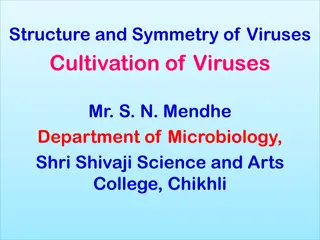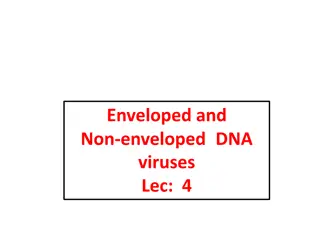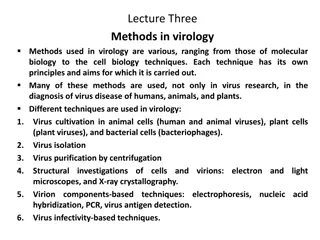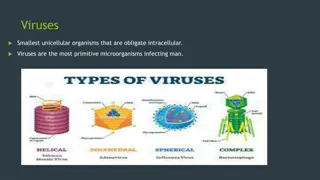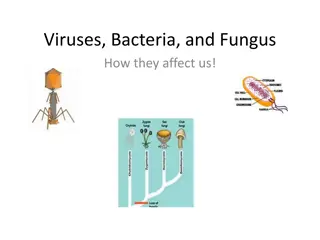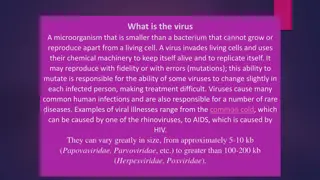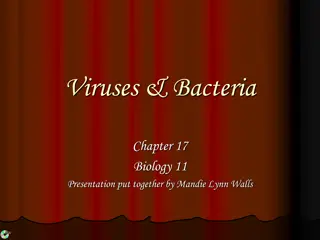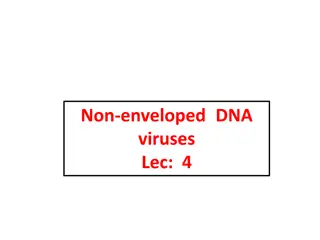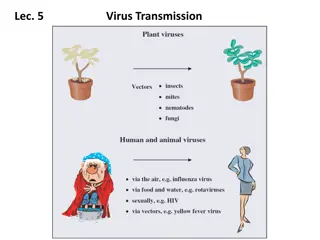Understanding the Basics of Virology: Viruses, Viroids, and Prions
Virology explores the world of viruses, infectious agents with living and nonliving characteristics. Viruses, noncellular genetic elements, depend on host cells for replication and lack metabolic functions on their own. Viroids and prions are novel entities related to viruses. Viruses are classified based on the organisms they infect and their structural features. The ICTV offers a hierarchical system for viral classification. Delve into the intricate dynamics of virology to grasp the fundamental principles governing these microorganisms.
Uploaded on Nov 15, 2024 | 0 Views
Download Presentation

Please find below an Image/Link to download the presentation.
The content on the website is provided AS IS for your information and personal use only. It may not be sold, licensed, or shared on other websites without obtaining consent from the author. Download presentation by click this link. If you encounter any issues during the download, it is possible that the publisher has removed the file from their server.
E N D
Presentation Transcript
Virology Virology Prepared by: Dr.Mohammed Almaziny
Viruses: are noncellular genetic elements that use a living cell for their replication and have an extracellular state. Without a host cell, viruses cannot carry out their life-sustaining functions or reproduce. Because : -They cannot synthesize proteins, because they lack ribosomes and must use the ribosomes of their host cells to translate viral messenger RNA (mRNA) into viral proteins. - Viruses cannot generate or store energy in the form of adenosine triphosphate (ATP), but have to derive their energy, and all other metabolic functions, from the host cell. - They also parasitize the cell for basic building materials, such as amino acids, nucleotides, and lipids (fats).
Viruses are infectious agents with both living and nonliving characteristics. 1. Living characteristics of viruses. a. They reproduce at a fantastic rate, but only in living host cells. b. They can mutate. 2. Nonliving characteristics of viruses. a. They are acellular (they contain no cytoplasm or cellular organelles). b. They carry out no metabolism on their own and must replicate using the host cell's metabolic machinery. In other words, viruses don't grow and divide. Instead, new viral components are synthesized and assembled within the infected host cell. c. The vast majority of viruses possess either DNA or RNA but not both.
Viron vs Viriod vs Prions - Outside the host cell, the virus particle is also known as a virion. The virion is metabolically inert and does not grow or carry on respiratory or biosynthetic functions. Each virion contains at least one unique protein synthesized by specific genes in its nucleic acid. -Viroids: (meaning "virus-like") are disease-causing organisms that contain only nucleic acid and have no structural proteins. - Other virus-like particles called prions are composed primarily of a protein tightly integrated with a small nucleic acid molecule.
Classification - Viruses are generally classified by the organisms they infect, animals, plants, or bacteria. - Viruses are further classified into families and genera based on three structural considerations: (1) the type and size of their nucleic acid. (2) the size and shape of the capsid. (3) whether they have a lipid envelope surrounding the nucleocapsid (the capsid enclosed nucleic acid).
Using these and other criteria, the International Committee on Taxonomay of Viruses (ICTV) produced the following the hierarchical system for viral classification: 1) Orders (virales): Groupings of families of viruses that share common characteristics and are distinct from other orders and families. 2) Families (-viridae): Groupings of genera of viruses that share common characteristics and are distinct from the member viruses of other families. 3) Subfamilies (-virinae): Not used in all families, but allows for more complex hierarchy of taxa. 4) Genera (-virus): Groupings of species of viruses that share common characteristics and are distinct from the member viruses of other species. 5) Species (virus); The definition accepted by ICTV is "a virus species is defined as a polythetic class of viruses that constitutes a replicating lineage and occupies a particular ecological niche". A species can be further broken down into strains, variants, etc.
In addition to this formal taxonomy, David Baltimore proposed that viruses be classified according to the nature of their genome and the relationship between the genome and the viral mRNA. The classes that he proposed are the following: Dr. David Baltimore2.jpg Class I: Double Stranded DNA Genomes Class II: Single Stranded DNA Genomes Class III: Double Stranded RNA Genomes Class IV: Positive Strand RNA Genomes Class V: Negative Strand RNA Genomes Class VI: Single stranded RNA-RT viruses (Retroviruses). Class VII: Double stranded DNA-RT viruses
Virus Morphology Viruses vary considerably in size and shape. The smallest viruses are about 0.02 m (20 nanometers), while the large viruses measure about 0.3 m (300 nanometers). Smallpox viruses are among the largest viruses; polioviruses are among the smallest. There are predominantly two kinds of shapes found amongst viruses: rods, or filaments, and spheres. The rod shape is due to the linear array of the nucleic acid and the protein subunits making up the capsid. The sphere shape is actually a 20-sided polygon (icosahedron).
An array of viruses. (a) The helical virus of rabies. (b) The segmented helical virus of influenza. (c) A bacteriophage with an icosahedral head and helical tail. (d) An enveloped icosahedral herpes simplex virus. (e) The unenveloped polio virus. (f) The icosahedral human immunodeficiency virus with spikes on its envelope.
Capsid: The capsid is the protein shell that encloses the nucleic acid; with its enclosed nucleic acid, it is called the nucleocapsid. This shell is composed of protein organized in subunits known as capsomers. They are closely associated with the nucleic acid and reflect its configuration, either a rod-shaped helix or a polygon-shaped sphere. The capsid has three functions: (1) it protects the nucleic acid from digestion by enzymes, (2) contains special sites on its surface that allow the virion to attach to a host cell. (3) provides proteins that enable the virion to penetrate the host cell membrane and, in some cases, to inject the infectious nucleic acid into the cell's cytoplasm.
Envelope: Many types of virus have a glycoprotein envelope surrounding the nucleocapsid. The envelope is composed of two lipid layers interspersed with protein molecules (lipoprotein bilayer) and may contain material from the membrane of a host cell as well as that of viral origin. Many viruses also develop spikes made of glycoprotein on their envelopes that help them to attach to specific cell surfaces. Enveloped viruses are formed by budding through cellular membranes, usually the plasma membrane but sometimes an internal membrane such as the ER, golgi, or nucleus.
Nucleic Acid: Just as in cells, the nucleic acid of each virus encodes the genetic information for the synthesis of all proteins. While the double-stranded DNA is responsible for this in prokaryotic and eukaryotic cells, only a few groups of viruses use DNA. Most viruses maintain all their genetic information with the single- stranded RNA. There are two types of RNA-based viruses. In most, the genomic RNA is termed a plus strand because it acts as messenger RNA for direct synthesis (translation) of viral protein. A few, however, have negative strands of RNA. In these cases, the virion has an enzyme, called RNA-dependent RNA polymerase (transcriptase), which must first catalyze the production of complementary messenger RNA from the virion genomic RNA before viral protein synthesis can occur.
Viral replication During the process of viral replication, a virus induces a living host cell to synthesize the essential components for the synthesis of new viral particles. The particles are then assembled into the correct structure , and the newly formed virions escape from the cell to infect other cells. The viral replication steps are as follows: 1- Attachment The first step in the replication process is attachment. In this step, the virus adsorbs to a susceptible host cell. High specificity exists between virus and cell, and the envelope spikes may unite with cell surface receptors. Receptors may exist on bacterial pili or flagella or on the host cell membrane.
2- Penetration and uncoating The next step is penetration and uncoating of the virus or the viral genome into the cell. This step may occur by phagocytosis; or the envelope of the virus may blend with the cell membrane; or the virus may inject its genome into the host cell (Bacteriophage).
3- Replication The replication steps of the process occur next. The protein capsid is stripped away from the genome, and the genome is freed in the cell cytoplasm. - If the genome consists of RNA, the genome acts as a messenger RNA (mRNA) molecule and provides the genetic codes for the synthesis of enzymes. The enzymes are used for the synthesis of viral genomes and capsomeres and the assembly of these components into new viruses. - If the viral genome consists of DNA, it provides the genetic code for the synthesis of messenger RNA molecules, and the process proceeds.
4- Assembly Once the viral genomes and capsomeres have been synthesized, they are assembled to form new virions. This assembly may take place in the cytoplasm or in the nucleus of the host cell. After the assembly is complete, the virions are ready to be released into the environment 5. Release For the release of new viral particles, any of a number of processes may occur. For example, the host cell may be biochemically exhausted, and it may disintegrate, thereby releasing the virions.
A generalized representation of the replication of two viruses. - Replication of a DNA virus is shown in (1) - Replication of an RNA virus is displayed in (2).
Lytic cycle The life cycle of viruses follows a basic pattern that involved entering a host and using that cell's machinery to create new virus particles which are then released an spread out to infect new cells. While there are variations, the process involves a basic set of steps. The Lytic cycle ends with the destruction of the host cell (lysis) and release of many new viruses. The whole process may take a few hours to a few days.
Lysogeny Cycle. Not all viruses multiply by the lytic cycle of reproduction. Certain viruses remain active within their host cells for a long period without replicating. This cycle is called the lysogenic cycle. The viruses are called temperate viruses, or proviruses, because they do not bring death to the host cell immediately. In lysogeny, the temperate virus exists in a latent form within the host cell and is usually integrated into the chromosome. Bacteriophages that remain latent within their bacterial host cell are called prophages. An example of lysogeny occurs in HIV infection. In this case, the human immunodeficiency virus remains latent within the host T-lymphocyte. An individual whose infection is at this stage will not experience the symptoms of AIDS until a later date.
The Lysogenic Cycle Replication of the viral genome without destroying the host cell. The Lytic Cycle Culminates in the death of the host cell Virulent viruses reproduce only by lytic cyle. A temperate virus may reproduce by either cycle. Lambda virus: resembles T4 but only has a single short tail fiber Natural selection favors bacterial mutations with receptor sites that are resistant to a particular phage or that have restriction enzymes to destroy the phages.
Bacteriophages - are viruses that multiply within bacteria. - These viruses are among the more complex viruses. - They often have icosahedral heads and helical tails. - The virus that attacks and replicates in Escherichia coli has 20 different proteins in its helical tail and a set of numerous fibers and pins. - Bacteriophages contain DNA and are important tools for viral research. - These bacterial viruses follow all the same steps as the lytic cycle: Adsoprtion/Attachment, Penetration, Synthesis, Assembly and Release.
Viral diseases Viruses cause a number of diseases in eukaryotes. In humans, smallpox, the common cold, chickenpox, influenza, shingles, herpes, polio, rabies, Ebola, hanta fever, and AIDS are examples of viral diseases. Even some types of cancer -- though definitely not all -- have been linked to viruses. Examples of viral diseases: - Human Papillomavirus (HPV) is a highly contagious virus that can be transmitted through intercourse. HPV causes no symptoms in some people. Others have been known to develop genital wart and even cancer from the virus. HPV causes many different kinds of warts such as plantar warts, genital warts, and flat warts.
- Herpes Simplex Virus is a highly contagious virus transmitted by the shedding of the virus from the skin. It can be transmitted in saliva and vaginal secretions. Some people are exposed to it during birth by contact with the mother's blisters. Causes cold sores and genital herpes. Chicken pox which can lead to shingles later in life - Influenza is a viral illness that causes the flu. There is influenza A and influenza B. These viruses change or mutate each year. This is why we will probably never find a cure for the flu. - Rabies is a very serious viral infection that attacks the nervous system. If not treated it usually leads to death
- HIV is human immunodeficiency virus that causes HIV infection. Some people live for years with HIV, others will eventually get AIDS (acquired immune deficiency syndrome). HIV and AIDS attack the body's immune system. - Ebola was discovered in 1976 in Africa. It is considered a hemorrhagic virus. This refers to the fact that the virus interferes with the cell lining of blood vessels and with the bodies clotting ability. This interference cases massive hemorrhaging and eventual death from blood loss.




